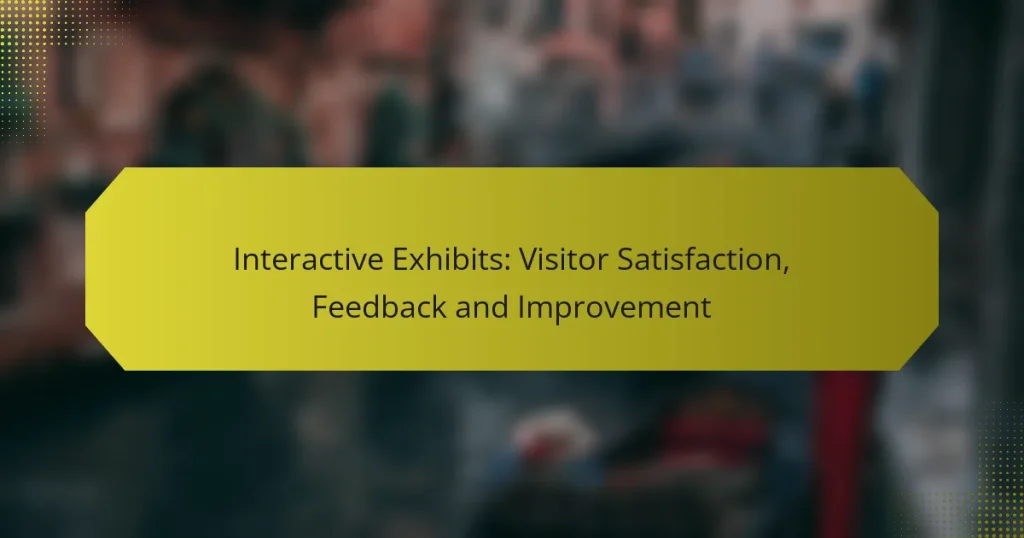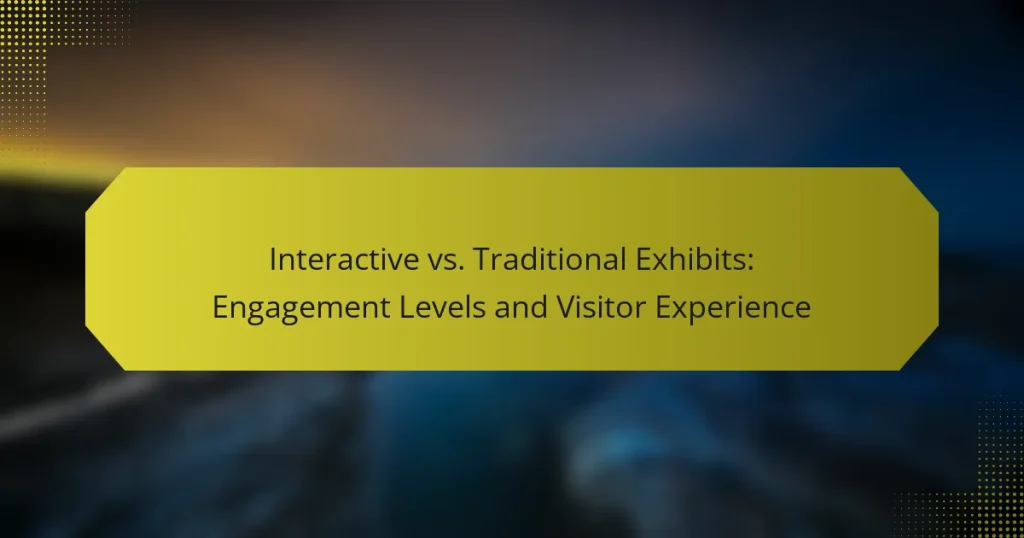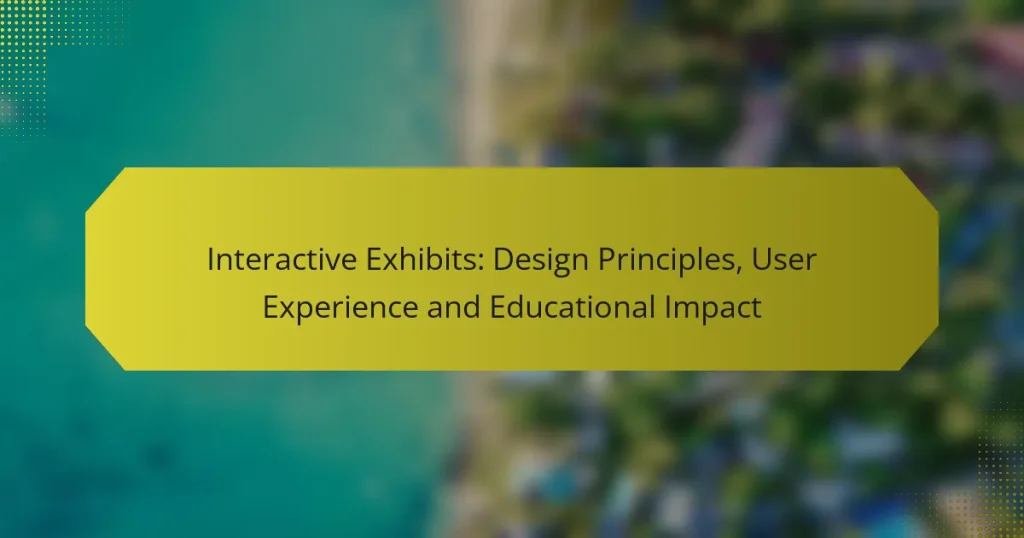Discover the excitement of science and technology through immersive museum tours that feature interactive exhibits designed to engage visitors of all ages. These hands-on experiences not only make complex concepts more accessible but also foster a deeper understanding of scientific principles. With knowledgeable guides and unique artifacts, each tour offers a memorable journey into the world of innovation and discovery.
Interactive Exhibits: Visitor Satisfaction, Feedback and Improvement
Interactive Exhibits: Selection Criteria, Engagement Metrics and Visitor Experience
Interactive vs. Traditional Exhibits: Engagement Levels and Visitor Experience
Interactive Exhibits: Design Principles, User Experience and Educational Impact
Interactive Experiences: Technology Integration, Immersion and User Interaction
Interactive Exhibits: Family Engagement, Educational Value and Fun
What are the best science and technology museum tours in the United States?
The best science and technology museum tours in the United States offer engaging, interactive experiences that cater to a wide range of interests. These tours often feature hands-on exhibits, knowledgeable guides, and unique artifacts that bring science and technology to life.
Smithsonian National Air and Space Museum
The Smithsonian National Air and Space Museum in Washington, D.C. is renowned for its extensive collection of historic aircraft and spacecraft. Visitors can explore interactive exhibits that detail the history of aviation and space exploration, including the Apollo 11 command module and the Wright brothers’ plane.
Consider joining a guided tour to gain deeper insights into the exhibits and their significance. The museum also offers special programs and events, making it a dynamic destination for families and enthusiasts alike.
California Science Center
Located in Los Angeles, the California Science Center features a variety of interactive exhibits that encourage hands-on learning. Notably, the Space Shuttle Endeavour is on display, allowing visitors to experience space travel up close.
Plan your visit to coincide with special exhibitions or IMAX films for an enhanced experience. The center also offers educational programs for all ages, making it a great choice for school groups and families.
Exploratorium in San Francisco
The Exploratorium in San Francisco is an interactive museum that focuses on science, art, and human perception. With hundreds of exhibits, visitors can engage in experiments and activities that spark curiosity and creativity.
Take advantage of the museum’s evening hours for a unique experience, as it often hosts special events and workshops. The hands-on nature of the exhibits makes it particularly appealing for children and adults alike.
Science Museum of Virginia
The Science Museum of Virginia in Richmond offers a range of interactive exhibits that cover various scientific disciplines. Highlights include the IMAX theater and the museum’s live science demonstrations, which provide engaging learning opportunities.
Check the museum’s schedule for special events and traveling exhibits that may be available during your visit. The museum also emphasizes educational outreach, making it a valuable resource for local schools.
Boston Museum of Science
The Boston Museum of Science is one of the largest science museums in the world, featuring a wide array of exhibits on topics such as biology, physics, and engineering. The museum’s hands-on approach allows visitors to engage with science through interactive displays and live presentations.
Consider purchasing a membership for unlimited visits and discounts on special events. The museum also offers seasonal programs and workshops, making it a great destination for repeat visits throughout the year.
How do interactive exhibits enhance learning experiences?
Interactive exhibits enhance learning experiences by actively engaging visitors, making complex concepts more accessible and memorable. These exhibits encourage exploration and participation, fostering a deeper understanding of scientific principles through hands-on activities.
Hands-on engagement
Hands-on engagement allows visitors to physically interact with exhibits, which can significantly boost retention and comprehension. For example, a physics exhibit might let users experiment with levers and pulleys, providing a tangible understanding of mechanical advantage. This type of learning is often more impactful than passive observation.
To maximize hands-on engagement, museums can incorporate various materials and tools that encourage experimentation. Simple activities, like building structures with blocks or conducting small-scale chemical reactions, can captivate audiences of all ages.
Real-time feedback
Real-time feedback is crucial in interactive exhibits, as it helps visitors understand the consequences of their actions immediately. For instance, a digital display might show how changing variables affects an experiment, allowing users to learn from their mistakes and successes on the spot. This instant response reinforces learning and encourages further exploration.
Exhibits that provide visual or auditory feedback can enhance the experience. For example, a sound-based exhibit might change tones based on user input, making the learning process more engaging and informative.
Encouragement of critical thinking
Interactive exhibits promote critical thinking by challenging visitors to solve problems and make decisions. For example, an exhibit on environmental science might present a scenario where users must balance resource use with sustainability, prompting them to consider the broader implications of their choices. This approach encourages deeper cognitive engagement.
To foster critical thinking, museums should design exhibits that pose open-ended questions or dilemmas. This can lead to discussions among visitors, enhancing the learning experience through collaboration and diverse perspectives.
What are the unique features of interactive exhibits?
Interactive exhibits are designed to engage visitors through hands-on experiences that promote learning and exploration. These features often include technology-driven elements, real-time participation, and collaborative opportunities that enhance the educational value of the museum visit.
Augmented reality experiences
Augmented reality (AR) experiences blend digital content with the physical world, allowing visitors to interact with exhibits in innovative ways. For example, using a smartphone or AR glasses, guests can view 3D models of scientific phenomena or historical artifacts that enhance their understanding of the subject matter.
When engaging with AR, consider the accessibility of technology. Ensure that devices are available for those who may not have their own, and provide clear instructions on how to use the AR features effectively.
Live demonstrations
Live demonstrations are dynamic presentations that showcase scientific principles or technologies in action. These can range from chemistry experiments to robotics showcases, providing a captivating way for visitors to observe and learn.
To maximize the impact of live demonstrations, schedule them at regular intervals and promote them through signage and social media. This ensures that visitors can plan their visit around these engaging events, enhancing their overall experience.
Collaborative projects
Collaborative projects invite visitors to work together on tasks or challenges, fostering teamwork and problem-solving skills. These projects might include building structures, conducting experiments, or participating in art installations that reflect scientific concepts.
Encourage participation by creating clear guidelines and providing necessary materials. Offering small incentives, like badges or certificates, can motivate visitors to engage more fully in these collaborative experiences.
What criteria should I consider when choosing a museum tour?
When selecting a museum tour, consider factors such as age-appropriateness of exhibits, accessibility options, and the duration of the tour. These elements can significantly impact the overall experience, ensuring that it meets your needs and expectations.
Age-appropriateness of exhibits
Assessing the age-appropriateness of exhibits is crucial for ensuring an engaging experience. Many museums categorize their exhibits based on age groups, such as children, teens, and adults. Look for tours specifically designed for families or educational groups if you are visiting with younger audiences.
Some museums offer interactive exhibits that cater to various age levels, allowing younger visitors to engage through hands-on activities while providing deeper insights for older participants. Always check the museum’s website or contact them directly for guidance on suitable tours for specific age ranges.
Accessibility options
Accessibility is vital for ensuring all visitors can enjoy the museum experience. Check if the museum provides features such as wheelchair access, audio guides, or sign language interpreters. Many institutions are committed to inclusivity and offer resources for individuals with disabilities.
Before booking a tour, inquire about specific accessibility options available during the visit. This can include sensory-friendly tours for individuals with autism or quiet spaces for those needing a break from sensory overload.
Duration of the tour
The duration of the tour can greatly influence your overall experience. Tours typically range from one to three hours, depending on the depth of the exhibits and the level of interaction. Consider how much time you have available and what you hope to gain from the visit.
Shorter tours may provide a quick overview, while longer ones often allow for more in-depth exploration and interaction with exhibits. If you have specific interests, look for tours that focus on particular themes or collections, as these may offer a more tailored experience within a set timeframe.
What are the pricing options for science and technology museum tours?
Pricing for science and technology museum tours typically varies based on factors such as age, group size, and special exhibits. Many museums offer tiered pricing, including discounts for children, seniors, and students, as well as family packages.
General admission fees
General admission fees for science and technology museums generally range from around $10 to $30 per adult, with children often admitted for a lower fee or even free under certain age limits. Some museums may charge a flat rate for families, which can be more economical for larger groups.
It’s important to check if the museum offers any special days with reduced or waived admission fees, such as community days or promotional events. Additionally, many museums provide discounts for educational groups or school field trips, which can significantly lower costs.
Consider purchasing tickets online in advance, as many museums offer lower prices for pre-booked tickets compared to on-site purchases. Always review the museum’s website for the most current pricing and any available promotions before planning your visit.






